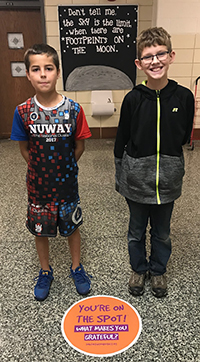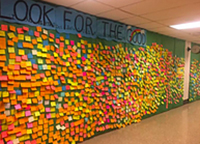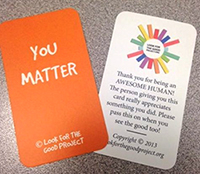December 18, 2018
With Thanksgiving behind us and the holidays in full swing, I thought it would be fitting to share some information about the important work schools are doing around the state to encourage kindness and gratitude. But first, the “why” behind these initiatives.
According to the Centers for Disease Control and Prevention (CDC), positive and negative childhood experiences have a profound impact on the health and opportunities available to our students. These early experiences are a critical public health issue. The research in this area has been referred to as Adverse Childhood Experiences, or ACEs. The CDC has found that nearly two-thirds of adults have reported at least one Adverse Childhood Experience, and the majority of adults who responded to the CDC study reported more than one.
This study looked at three categories of childhood experiences, including childhood abuse, neglect and household challenges. Childhood abuse included emotional, physical and sexual abuse. The neglect category included both emotional and physical neglect. Growing up in a household with substance abuse, mental illness, violence or divorce/separation were all included in the household challenges category. Adults responding to the survey were given an ACE score between zero and 10 based on how many of these experiences they reported being exposed to as a child. ACEs have an immense impact on the health and quality of life of students, as the study found links between adverse childhood experiences and risky behavior, psychological concerns, serious illnesses and more.
However, the good news is we can make a difference! I often think about the circle of control in my classroom. I can’t control what happens in a child’s home. However, I can control the tools that my students are able to access to beat the odds and overcome childhood trauma.
The Look for the Good project is designed to reverse some of the negative impacts of ACEs by equipping students with a wide range of positive actions and opportunities to put those actions into practice. This project gives students and teachers the opportunity to be constructive and creative while developing resources for their lives to make them more resilient. Harvard University reports that children who are grateful are happier, more cooperative in school and at home, more generous in their thoughts and actions, and more likely to use their strengths to enhance their community.
There are four main components in the Look for the Good project, including Gratitude Spots, a Gratitude Wall, “You Matter” letters and Kindness cards.

Gratitude spots are placed throughout the school. As students walk over the spot, they are invited to think about what makes them grateful. These spots are strategically placed in the hallways all around the school in areas which students frequently travel to give them the chance to step on the spot and share their gratitude.

A Gratitude Wall is set up in the school to inspire the school community to be thankful and kind. Teachers and students add notes to the Gratitude Wall daily and watch their gratefulness grow.
Built into the school day is an opportunity for students to write “You Matter” letters to someone in their life who matters to them. Students write a letter to a classmate, a teacher, or a family member and describe how that person has impacted their life in a positive way. To take it one step further, the students deliver the letter to that person to see the impact that this kind gesture can have in another person’s life.

Hundreds of kindness cards are passed between students and staff throughout the school to inspire acts of kindness. This not only recognizes the unique contributions of each school community member but builds a positive school climate in which every student feels valued, appreciated and loved.
A schoolwide gratitude campaign like the Look for the Good project gives students an opportunity to take ownership in an initiative to build gratitude, kindness, and tools for resilience. But don’t take my word for it. Check out these
students and teachers from Sunset Lake Elementary in Vicksburg!
What initiatives have you used to encourage kindness and gratitude in your classroom?
 Laura Chang is Michigan’s Teacher of the Year for 2018-19, and Meemic is proud to partner with the Michigan Department of Education for the program. Laura is entering her nineteenth year of teaching at Sunset Lake Elementary in Vicksburg Community Schools, where she is currently a K-5 interventionist.
Laura Chang is Michigan’s Teacher of the Year for 2018-19, and Meemic is proud to partner with the Michigan Department of Education for the program. Laura is entering her nineteenth year of teaching at Sunset Lake Elementary in Vicksburg Community Schools, where she is currently a K-5 interventionist.